Trends and Scientific Production on Isometric Training: A Bibliometric Analysis
Abstract
1. Introduction
2. Materials and Methods
Type of Study
3. Results
3.1. Network Metrics
3.1.1. Annual Trend of Publications
3.1.2. Thematic Categories
3.1.3. Most Cited Papers
3.1.4. Prolific and Prominent Authors
3.1.5. Countries/Regions
3.1.6. Nucleus of Journal
3.1.7. Keywords and Keywords Plus
4. Discussion
4.1. Annual Growth in Publications
4.2. Categories and Prolific Researchers
4.3. Most Used Keywords
4.4. Strengths and Limitations
4.5. Suggestions and General Practices and Applications for Future Lines of Research
- First, it is essential to establish standardized Web of Science (WoS) categories and select journals that fit the scope of this specific area of training, in order to improve the coherence, visibility, and comparability of studies in future research.
- Second, it is essential to promote international consensus among researchers to consolidate the development of the area of study and standardize methodological and conceptual approaches related to this topic.
- Finally, special attention should be paid to the careful selection and consistent use of keywords.
5. Conclusions
Supplementary Materials
Author Contributions
Funding
Institutional Review Board Statement
Informed Consent Statement
Acknowledgments
Conflicts of Interest
References
- Lum, D.; Barbosa, T. Brief review: Effects of isometric strength training on strength and dynamic performance. Int. J. Sports Med. 2018, 40, 363–375. [Google Scholar] [CrossRef]
- Ríos Riquelme, M.; Marín Guajardo, C.; Loro Ferrer, J.F.; Cofre Bolados, C.; Castillo-Paredes, A. Efectos de los ejercicios isométricos sobre el rendimiento, fuerza, potencia o aptitud en jóvenes y adultos: Una revisión narrativa. Retos 2024, 61, 1290–1297. [Google Scholar] [CrossRef]
- Hettinger, T.; Muller, E.A. Muskelleistung und Muskeltraining [Muscle capacity and muscle training]. Arbeitsphysiologie Int. Z. Fur Angew. Physiologie 1953, 15, 111–126. [Google Scholar]
- Bravo Ducal, J. Esquemas del entrenamiento por contracciones isométricas. Apunt. Med. De L” Esport 1965, 2, 115–120. Available online: https://www.apunts.org/en-pdf-X0213371765040551 (accessed on 20 September 2024).
- Khuniengson, F.M.B.; Olivera, S.A.M.; Pascual, L.M.J. Batería de ejercicios físicos para prevenir las enfermedades cardiovasculares. Rev. Cuba. De Med. Del Deporte Y la Cultura Física 2020, 12. Available online: https://revmedep.sld.cu/index.php/medep/article/download/84/85/389 (accessed on 20 September 2024).
- Rio, E.; Kidgell, D.; Purdam, C.; Gaida, J.; Moseley, G.L.; Pearce, A.J.; Cook, J. Isometric exercise induces analgesia and reduces inhibition in patellar tendinopathy. Br. J. Sports Med. 2015, 49, 1277–1283. [Google Scholar]
- Oranchuk, D.; Storey, A.; Nelson, A.; Cronin, J. Scientific basis for quasi-isometric eccentric resistance training: A narrative review. J. Strength Cond. Res. 2019, 33, 2848–2859. [Google Scholar] [CrossRef]
- Carlson, D.; Dieberg, G.; Hess, N.; Millar, P.; Smart, N. Isometric exercise training for blood pressure management: A systematic review and meta-analysis. Mayo Clin. Proc. 2014, 89, 327–334. [Google Scholar] [CrossRef]
- Inder, J.D.; Carlson, D.J.; Dieberg, G.; McFarlane, J.R.; Hess, N.C.; Smart, N.A. Isometric exercise training for blood pressure management: A systematic review and meta-analysis to optimize benefit. Hypertens. Res. Off. J. Jpn. Soc. Hypertens. 2016, 39, 88–94. [Google Scholar] [CrossRef]
- Rajameena, R.; Nilishna, R.A.I. Isometric exercise and inspiratory muscle training as an antihypertensive treatment in the elderly population. Int. J. Multidisci-Plinary Res. 2023, 5. [Google Scholar] [CrossRef]
- Wehrmann, A.; Tian, E.; Tyack, E.; Kumar, S. Evidence of the effectiveness of isometric resistance training in managing hypertension in adults: A general review. Blood Press. Monit. 2023, 28, 171–184. [Google Scholar] [CrossRef]
- Pinto, D.; Dias, N.; Garcia, C.; Teixeira, M.; Marques, M.; Amaral, T.; Amaral, L.; Abreu, R.; Figueiredo, D.; Polónia, J.; et al. Effect of home-based isometric training on blood pressure in older adults with high normal BP or stage I hypertension: A randomized controlled trial. J. Am. Geriatr. Soc. 2024, 73, 574–582. [Google Scholar] [CrossRef]
- Jae, S.; Yoon, E.; Kim, H.; Cho, M. PS-C25-9: Comparison of antihypertensive effects of isometric handgrip versus aerobic exercise in elderly hypertensive patients: A randomized controlled trial. J. Hypertens. 2023, 41, e413. [Google Scholar] [CrossRef]
- Menolin, T.; Suryakaran, R. A Study to Assess the Effectiveness of Isometric Exercise on Improved Function Performance Among Older Adults with Osteo-Arthritis; St. Thomas Old Age Home. Int. J. Sci. Res. (IJSR) 2019, 8, 1652–1654. Available online: https://www.ijsr.net/getabstract.php?paperid=ART202010 (accessed on 20 September 2024).
- Guiraud, T.; Labrunée, M.; Besnier, F.; Sénard, J.; Pillard, F.; Rivière, D.; Richard, L.; Laroche, D.; Sanguignol, F.; Pathak, A.; et al. Whole-body strength training with Huber Motion Lab and traditional strength training in cardiac rehabilitation: A randomized controlled study. Ann. Phys. Med. Reha-Bilitation 2017, 60, 20–26. [Google Scholar] [CrossRef]
- Silbernagel, K.; Vicenzino, B.; Rathleff, M.; Thorborg, K. Isometric exercise for acute pain relief: Is it relevant in tendinopathy management? Br. J. Sports Med. 2019, 53, 1330–1331. [Google Scholar] [CrossRef]
- Ylinen, J.; Takala, E.P.; Nykänen, M.; Häkkinen, A.; Mälkiä, E.; Pohjolainen, T.; Karppi, S.L.; Kautiainen, H.; Airaksinen, O. Active neck muscle training in the treatment of chronic neck pain in women: A randomized controlled trial. JAMA 2003, 289, 2509–2516. [Google Scholar] [CrossRef]
- Yang, J.; Yang, M.; Lin, Q.; Fu, J.; Xi, R. Effects of isometric training in the treatment of patients with neck pain: A meta-analysis. Medicine 2022, 101, e30864. [Google Scholar] [CrossRef]
- Topp, R.; Woolley, S.; Hornyak, J.; Khuder, S.; Kahaleh, B. The effect of dynamic versus isometric resistance training on pain and functioning among adults with osteoarthritis of the knee. Arch. Phys. Med. Rehabil. 2002, 83, 1187–1195. [Google Scholar] [CrossRef]
- Park, S.; Min, S.; Park, S.; Yoo, J.; Jee, Y. Influence of Isometric Exercise Combined with Electrostimulation on Inflammatory Cytokine Levels, Muscle Strength, and Knee Joint Function in Elderly Women with Early Knee Osteoarthritis. Front. Physiol. 2021, 12, 688260. [Google Scholar] [CrossRef]
- Lee, B.; McGill, S. The Effect of Long-Term Isometric Training on Torso and Core Stiffness. J. Strength Cond. Res. 2015, 29, 1515–1526. [Google Scholar] [CrossRef] [PubMed]
- Lim, H.; Wong, S. Effects of Eccentric or Slow Heavy Resistance Isometric Exercises on Pain and Function in Individuals with Patellar Tendinopathy: A Systematic Review. Physiother. Res. Int. 2018, 23, e1721. [Google Scholar] [CrossRef] [PubMed]
- Choi, Y.; Kim, B.; Hwang, Y.; Moon, O.; Choi, W. Effects of Isometric Exercise with Biofeedback on Maximum Voluntary Isometric Contraction, Pain, and Muscle Thickness in Patients with Knee Osteoarthritis. J. Phys. Ther. Sci. 2015, 27, 149–153. [Google Scholar] [CrossRef][Green Version]
- Donthu, N.; Kumar, S.; Mukherjee, D.; Pandey, N.; Lim, W.M. How to conduct a bibliometric analysis: An overview and guidelines. J. Bus. Res. 2021, 133, 285–296. [Google Scholar] [CrossRef]
- Bradford, S.C. Sources of information on specific subjects. Engineering 1934, 137, 85–86. [Google Scholar]
- Small, H. Co-citation in the scientific literature: A new measure of the relationship between two documents. J. Am. Soc. Inf. Sci. 1973, 24, 265–269. [Google Scholar] [CrossRef]
- White, H.D.; Griffith, B.C. Author cocitation: A literature measure of intellectual structure. J. Am. Soc. Inf. Sci. 1981, 32, 163–171. [Google Scholar] [CrossRef]
- Baffour-Awuah, B.; Pearson, M.J.; Dieberg, G.; Smart, N.A. Isometric Resistance Training to Manage Hypertension: Systematic Review and Meta-Analysis. Curr. Hypertens. Rep. 2023, 25, 35–49. [Google Scholar] [CrossRef] [PubMed]
- Cornelissen, V.A.; Smart, N.A. Exercise Training for Blood Pressure: A Systematic Review and Meta-Analysis. J. Am. Heart Assoc. 2013, 2, e004473. [Google Scholar] [CrossRef]
- Lake, D.A. Neuromuscular Electrical Stimulation: An Overview and Its Application in the Treatment of Sports Injuries. Sports Med. 1992, 13, 320–336. [Google Scholar] [CrossRef]
- Loaiza-Betancur, A.F.; Pérez Bedoya, E.; Montoya Dávila, J.; Chulvi-Medrano, I. Effect of Isometric Resistance Training on Blood Pressure Values in a Group of Normotensive Participants: A Systematic Review and Meta-Analysis. Sports Health 2020, 12, 256–262. [Google Scholar] [CrossRef] [PubMed]
- Clarivate. Clarivate Web of Science. Available online: https://mjl.clarivate.com/home (accessed on 27 September 2024).
- Contreras-Barraza, N.; Espinosa-Cristia, J.F.; Salazar-Sepulveda, G.; Vega-Muñoz, A.; Ariza-Montes, A. A Scientometric Systematic Review of Entrepreneurial Wellbeing Knowledge Production. Front. Psychol. 2021, 12, 641465. [Google Scholar] [CrossRef]
- Fresno-Alba, S.; Denche-Zamorano, Á.; Pastor-Cisneros, R.; Pereira-Payo, D.; Franco-García, J.M.; Jiménez-Castuera, R. Breast Cancer and Physical Activity: A Bibliometric Analysis. Front. Oncol. 2023, 12, 1051482. [Google Scholar] [CrossRef] [PubMed]
- Contreras-Barraza, N.; Madrid-Casaca, H.; Salazar-Sepúlveda, G.; Garcia-Gordillo, M.Á.; Adsuar, J.C.; Vega-Muñoz, A. Bibliometric Analysis of Studies on Coffee/Caffeine and Sport. Nutrients 2021, 13, 3234. [Google Scholar] [CrossRef]
- Crespo, N.; Simoes, N. Publication Performance Through the Lens of the h-Index: How Can We Solve the Problem of the Ties? Soc. Sci. Q. 2019, 100, 2495–2506. [Google Scholar] [CrossRef]
- Hirsch, J.E. An Index to Quantify an Individual’s Scientific Research Output. Proc. Natl. Acad. Sci. USA 2005, 102, 16569–16572. [Google Scholar] [CrossRef]
- Bulick, S. Book Use as a Bradford-Zipf Phenomenon. Coll. Res. Libr. 1978, 39, 215–219. [Google Scholar] [CrossRef]
- Morse, P.M.; Leimkuhler, F.F. Exact Solution for the Bradford Distribution and Its Use in Modeling Informational Data. Oper. Res. 1979, 27, 187–198. [Google Scholar] [CrossRef]
- Muñoz-Urtubia, N.; Vega-Muñoz, A.; Estrada-Muñoz, C.; Salazar-Sepúlveda, G.; Contreras-Barraza, N.; Salinas-Martínez, N.; Méndez-Celis, P.; Carmelo-Adsuar, J. Wearable Biosensors for Human Health: A Bibliometric Analysis from 2007 to 2022. Digit. Health 2024, 10, 20552076241256876. [Google Scholar] [CrossRef]
- Lotka, A.J. The Frequency Distribution of Scientific Productivity. J. Wash. Acad. Sci. 1926, 16, 317–323. [Google Scholar]
- Koo, M. A Bibliometric Analysis of Two Decades of Aromatherapy Research. BMC Res. Notes 2017, 10, 1–9. [Google Scholar] [CrossRef] [PubMed]
- Kushairi, N.; Ahmi, A. Flipped Classroom in the Second Decade of the Millennia: A Bibliometric Analysis with Lotka’s Law. Educ. Inf. Technol. 2021, 26, 4401–4431. [Google Scholar] [CrossRef] [PubMed]
- Denche-Zamorano, A.; Rodriguez-Redondo, Y.; Barrios-Fernandez, S.; Mendoza-Muñoz, M.; Castillo-Paredes, A.; Rojo-Ramos, J.; Garcia-Gordillo, M.A.; Adsuar, J. Rehabilitation Is the Main Topic in Virtual and Augmented Reality and Physical Activity Research: A Bibliometric Analysis. Sensors 2023, 23, 2987. [Google Scholar] [CrossRef] [PubMed]
- Vittori, A.; Cascella, M.; Leonardi, M.; Monaco, F.; Nocerino, D.; Cuomo, A.; Ottaiano, A.; Perri, F.; Mascilini, I.; Francia, E.; et al. VOSviewer-Based Bibliometric Network Analysis for Evaluating Research on Juvenile Primary Fibromyalgia Syndrome (JPFS). Children 2022, 9, 637. [Google Scholar] [CrossRef]
- Rodríguez-Redondo, Y.; Denche-Zamorano, A.; Muñoz-Bermejo, L.; Rojo-Ramos, J.; Adsuar, J.C.; Castillo-Paredes, A.; Vega-Muñoz, A.; Barrios-Fernandez, S. Bibliometric Analysis of Nature-Based Therapy Research. Healthcare 2023, 11, 1249. [Google Scholar] [CrossRef]
- Pereira-Payo, D.; Denche-Zamorano, Á.; Mendoza-Muñoz, M.; Franco-García, J.M.; Carlos-Vivas, J.; Pérez-Gómez, J. Trends in Multicomponent Training Research in the Aged Population: A Bibliometric Analysis. Healthcare 2024, 12, 1493. [Google Scholar] [CrossRef]
- Sainaghi, R.; Phillips, P.; Baggio, R.; Mauri, A. Cross-Citation and Authorship Analysis of Hotel Performance Studies. Int. J. Hosp. Manag. 2018, 73, 75–84. [Google Scholar] [CrossRef]
- Amado-Fuentes, M.; Denche-Zamorano, A.; Barrios-Fernandez, S.; Gozalo, M. Bibliometric Analysis on Equine-Assisted Interventions. Animals 2024, 14, 1776. [Google Scholar] [CrossRef]
- Van Eck, N.; Waltman, L. Software Survey: VOSviewer, a Computer Program for Bibliometric Mapping. Scientometrics 2010, 84, 523–538. [Google Scholar] [CrossRef]
- Zipf, G.K. Selected Studies of the Principle of Relative Frequency in Language; Harvard University Press: Cambridge, MA, USA, 1932. [Google Scholar] [CrossRef]
- Valderrama-Zurián, J.C.; García-Zorita, C.; Marugán-Lázaro, S.; Sanz-Casado, E. Comparison of MeSH Terms and KeyWords Plus Terms for More Accurate Classification in Medical Research Fields: A Case Study in Cannabis Research. Inf. Process. Manag. 2021, 58, 102658. [Google Scholar] [CrossRef]
- Lynch, W.C.; Schuri, U.; D’Anna, J. Effects of Isometric Muscle Tension on Vasomotor Activity and Heart Rate. Psychophysiology 1976, 13, 222–230. [Google Scholar] [CrossRef]
- Paulsen, W.J.; Boughner, D.R.; Friesen, A.; Persaud, J.A. Ventricular Response to Isometric and Isotonic Exercise: Echocardiographic Assessment. Br. Heart J. 1979, 42, 521–527. [Google Scholar] [CrossRef]
- Naugle, K.M.; Fillingim, R.B.; Riley, J.L., III. A Meta-Analytic Review of the Hypoalgesic Effects of Exercise. J. Pain 2012, 13, 1139–1150. [Google Scholar] [CrossRef]
- Rust, P.; Ekmekcioglu, C. Impact of Salt Intake on the Pathogenesis and Treatment of Hypertension. Adv. Exp. Med. Biol. 2017, 956, 61–84. [Google Scholar] [CrossRef]
- Holden, S.; Lyng, K.; Graven-Nielsen, T.; Riel, H.; Olesen, J.L.; Larsen, L.H.; Rathleff, M.S. Isometric exercise and pain in patellar tendinopathy: A randomized crossover trial. J. Sci. Med. Sport 2020, 23, 208–214. [Google Scholar] [CrossRef]
- Rio, E.; van Ark, M.; Docking, S.; Moseley, G.L.; Kidgell, D.; Gaida, J.E.; van den Akker-Scheek, I.; Zwerver, J.; Cook, J. Isometric Contractions Are More Analgesic Than Isotonic Contractions for Patellar Tendon Pain: An In-Season Randomized Clinical Trial. Clin J Sport Med Off. J. Can. Acad. Sport Med. 2017, 27, 253–259. [Google Scholar] [CrossRef]
- van Ark, M.; Cook, J.L.; Docking, S.I.; Zwerver, J.; Gaida, J.E.; van den Akker-Scheek, I.; Rio, E. Do isometric and isotonic exercise programs reduce pain in athletes with patellar tendinopathy in-season? A randomised clinical trial. J. Sci. Med. Sport 2016, 19, 702–706. [Google Scholar] [CrossRef]
- Farah, B.; Germano-Soares, A.; Rodrigues, S.; Santos, C.; Barbosa, S.; Vianna, L.; Cornelissen, V.; Ritti-Dias, R. Acute and Chronic Effects of Isometric Handgrip Exercise on Cardiovascular Variables in Hypertensive Patients: A Systematic Review. Sports 2017, 5, 55. [Google Scholar] [CrossRef]
- Vang, C.; Niznik, A. The Effectiveness of Isometric Contractions Compared with Isotonic Contractions in Reducing Pain for In-Season Athletes with Patellar Tendinopathy. J. Sport Rehabil. 2020, 30, 512–515. [Google Scholar] [CrossRef] [PubMed]
- Belter, C.W. Bibliometric Indicators: Opportunities and Limits. J. Med. Libr. Assoc. 2015, 103, 219–221. [Google Scholar] [CrossRef] [PubMed]
- Romanelli, J.P.; Gonçalves, M.C.P.; de Abreu Pestana, L.F.; Soares, J.A.H.; Boschi, R.S.; Andrade, D.F. Four Challenges When Conducting Bibliometric Reviews and How to Deal with Them. Environ. Sci. Pollut. Res. 2021, 28, 60448–60458. [Google Scholar] [CrossRef]
- Price, D.S. Little Science, Big Science—And Beyond; Columbia University Press: New York, NY, USA, 1986; pp. 5–29. [Google Scholar]
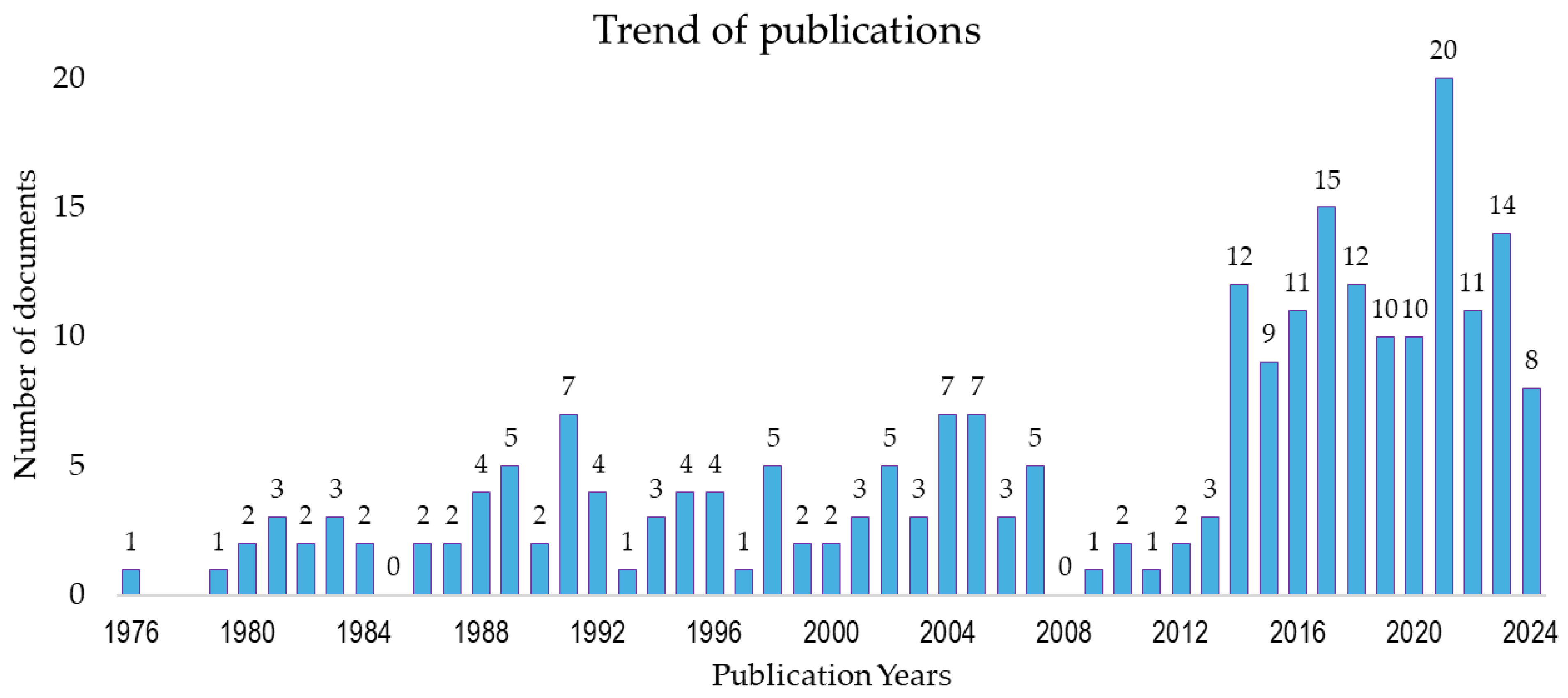
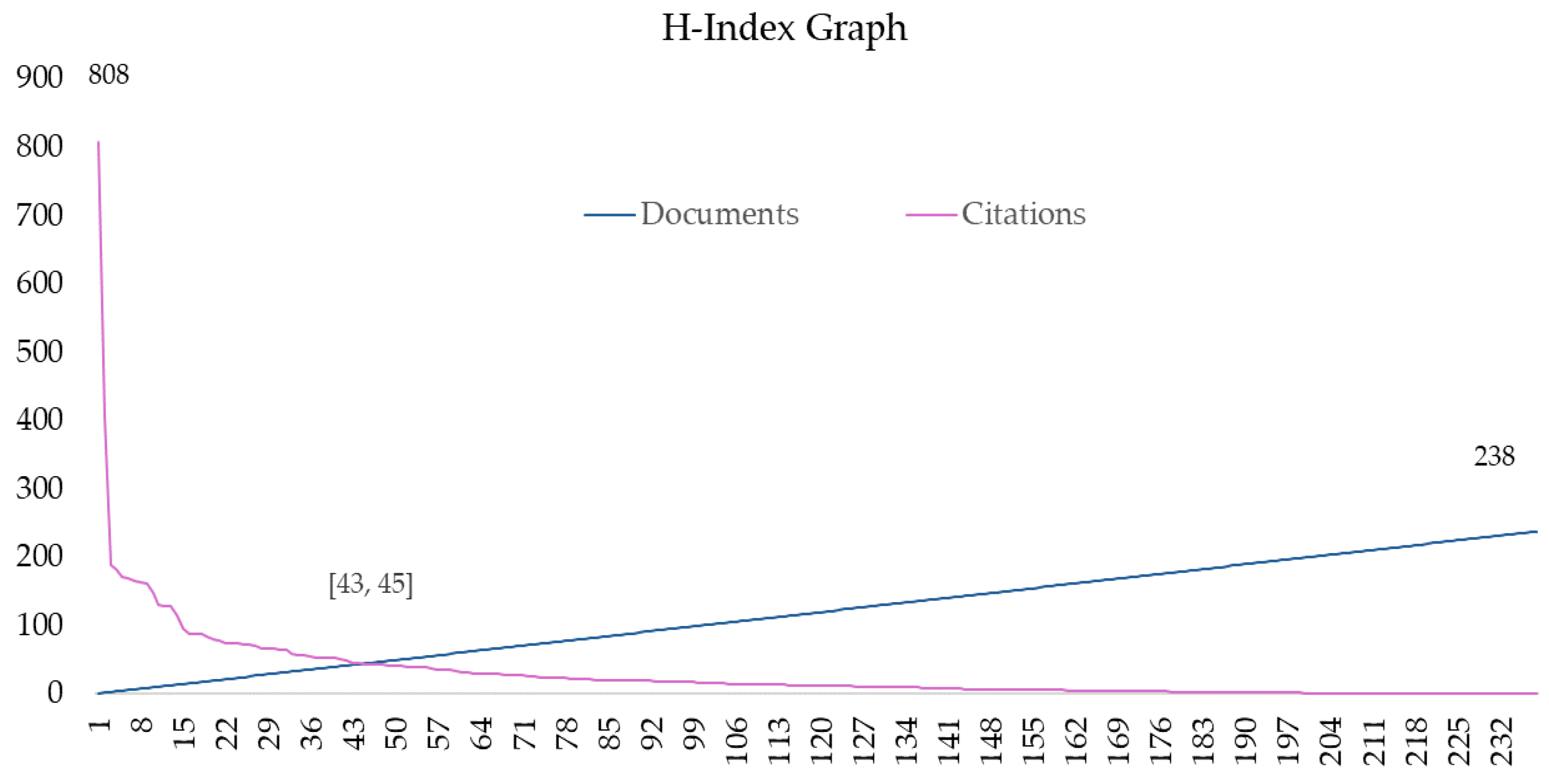
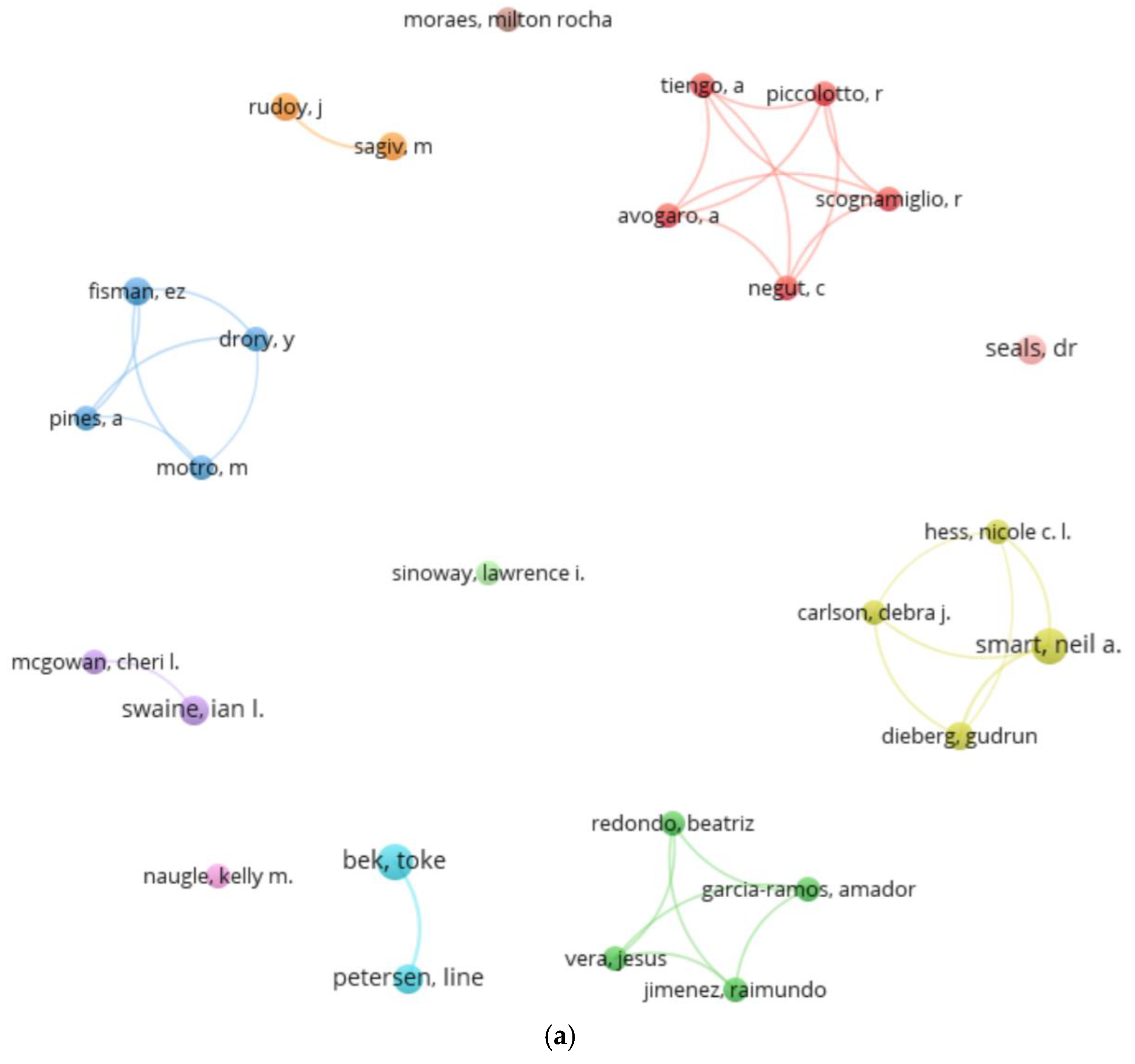
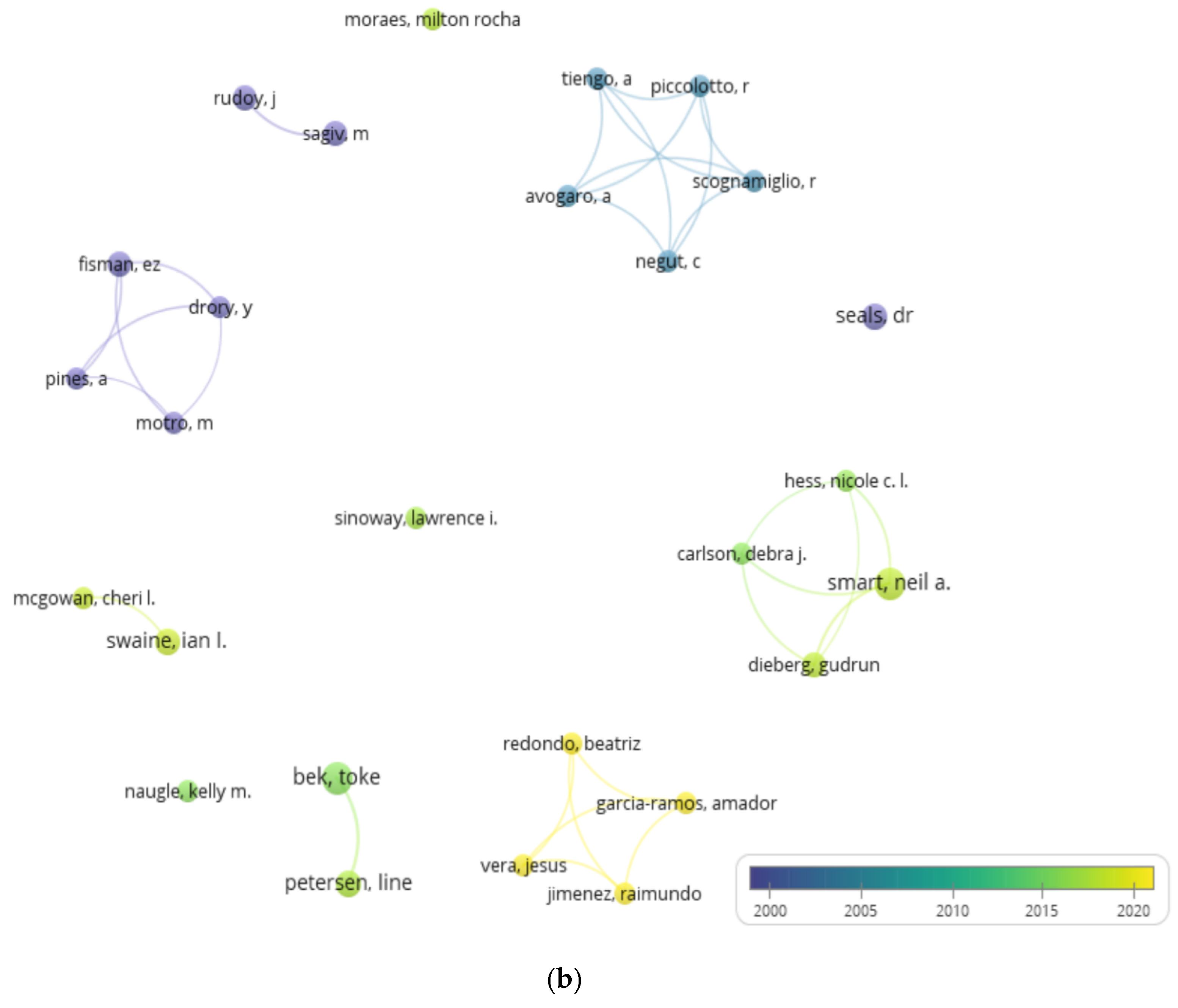
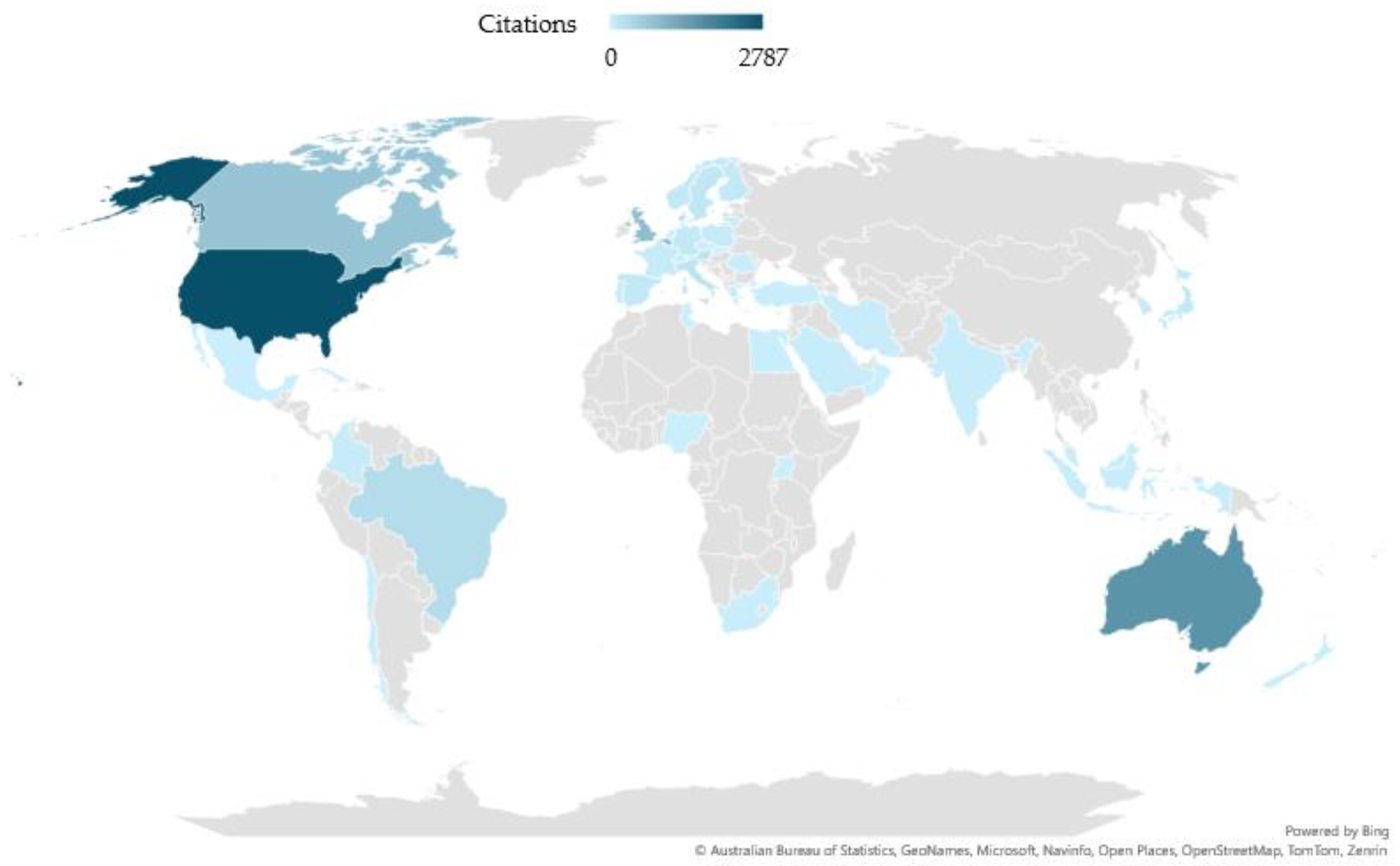
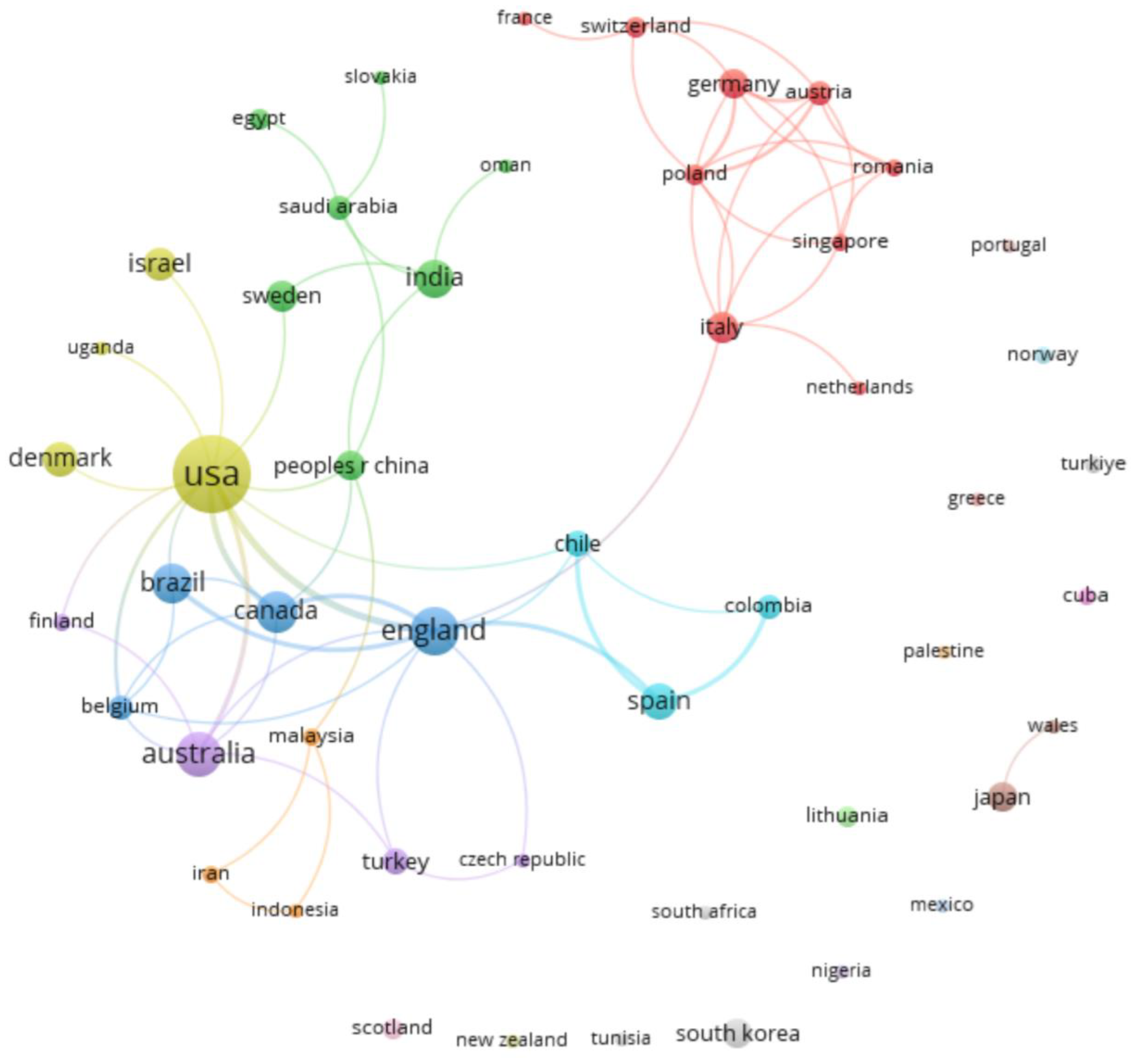
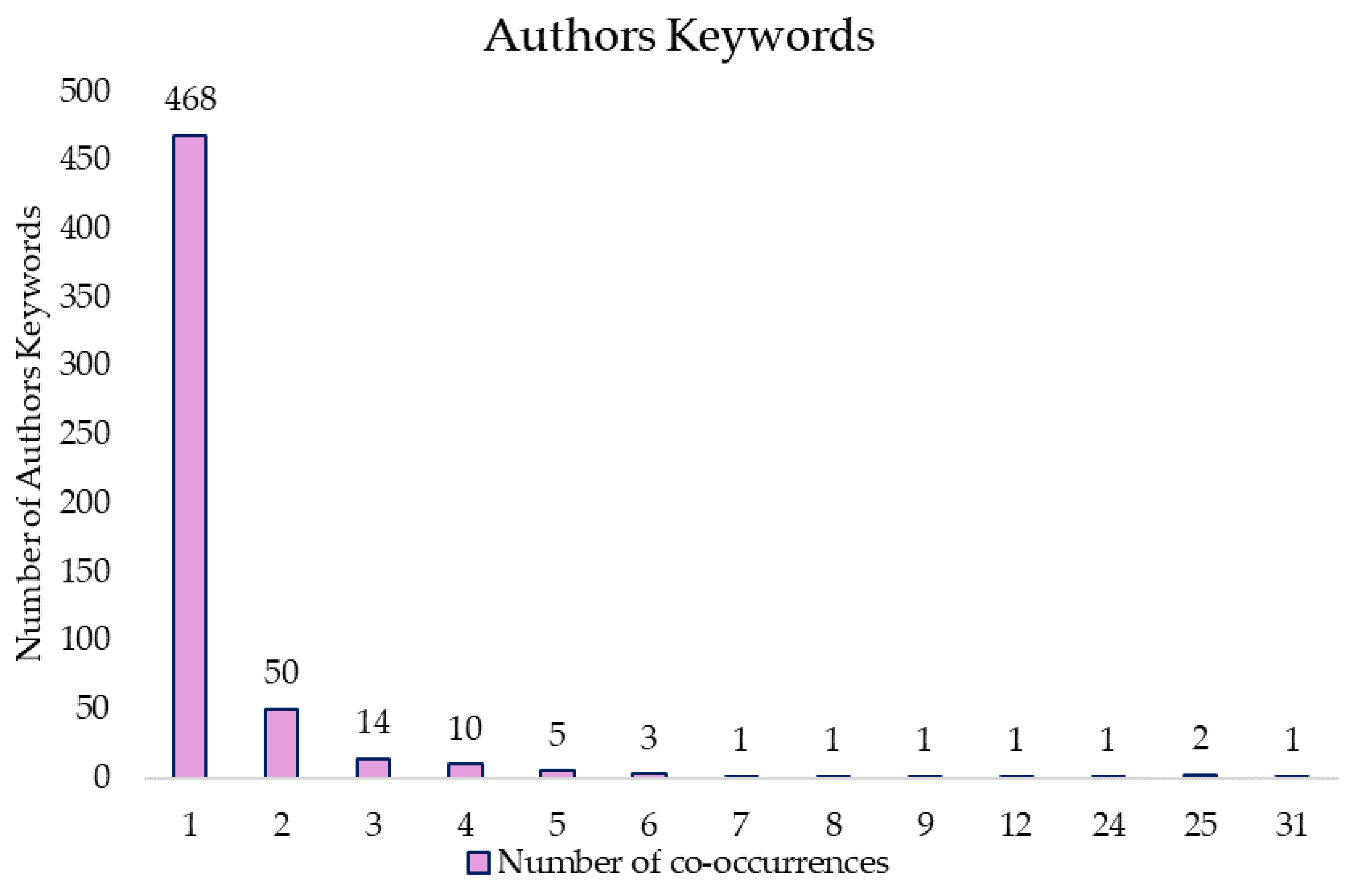
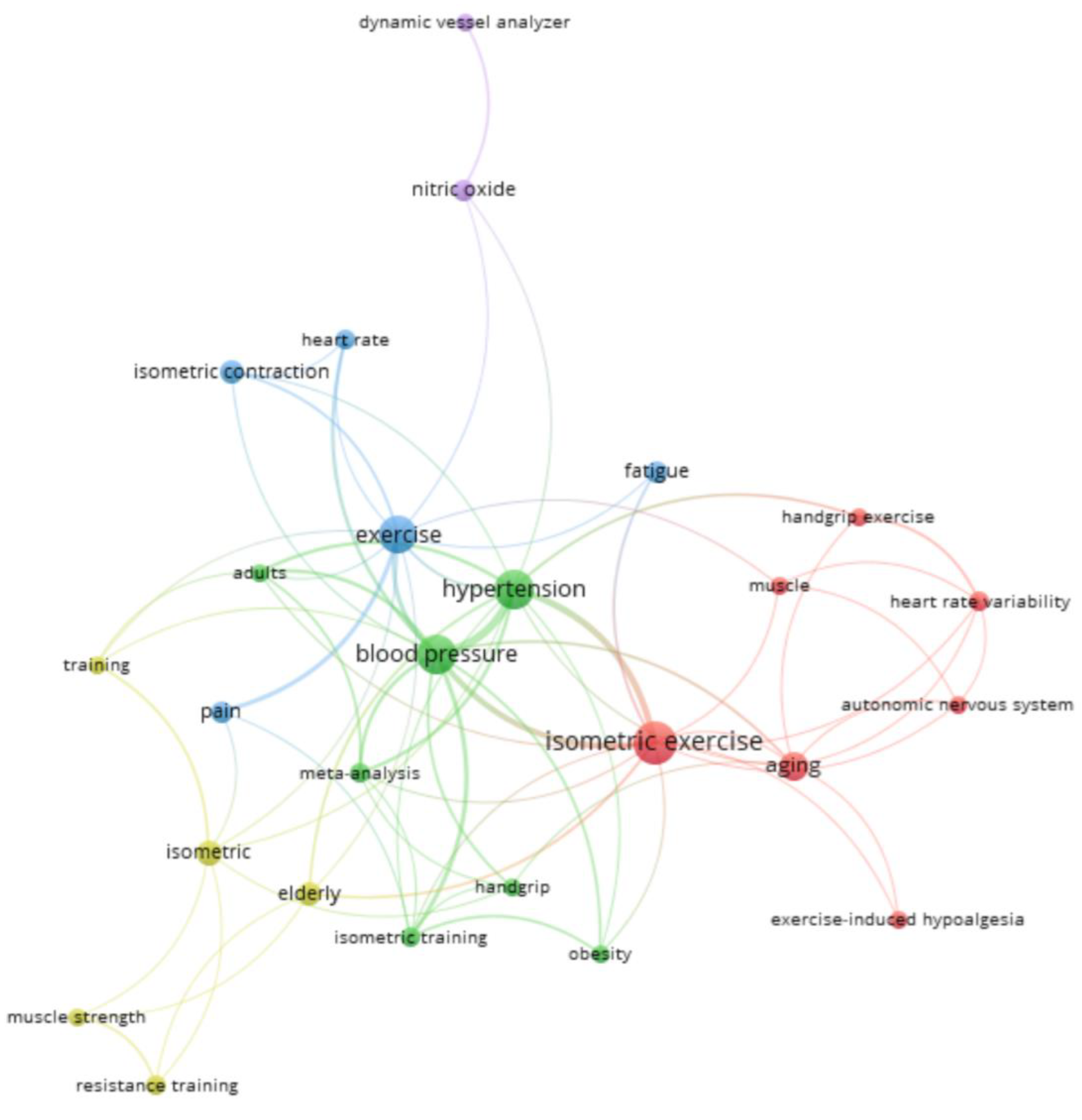
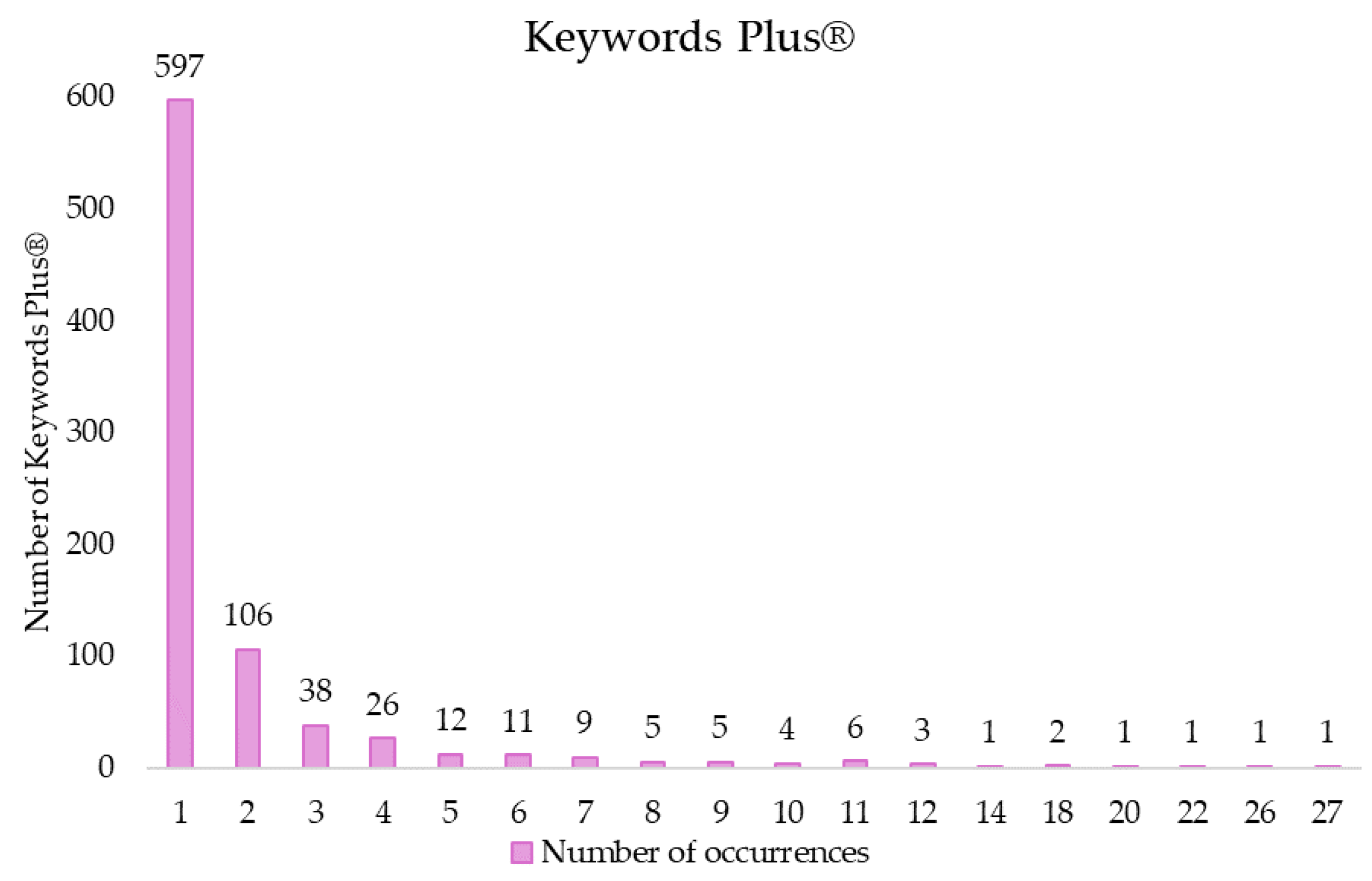
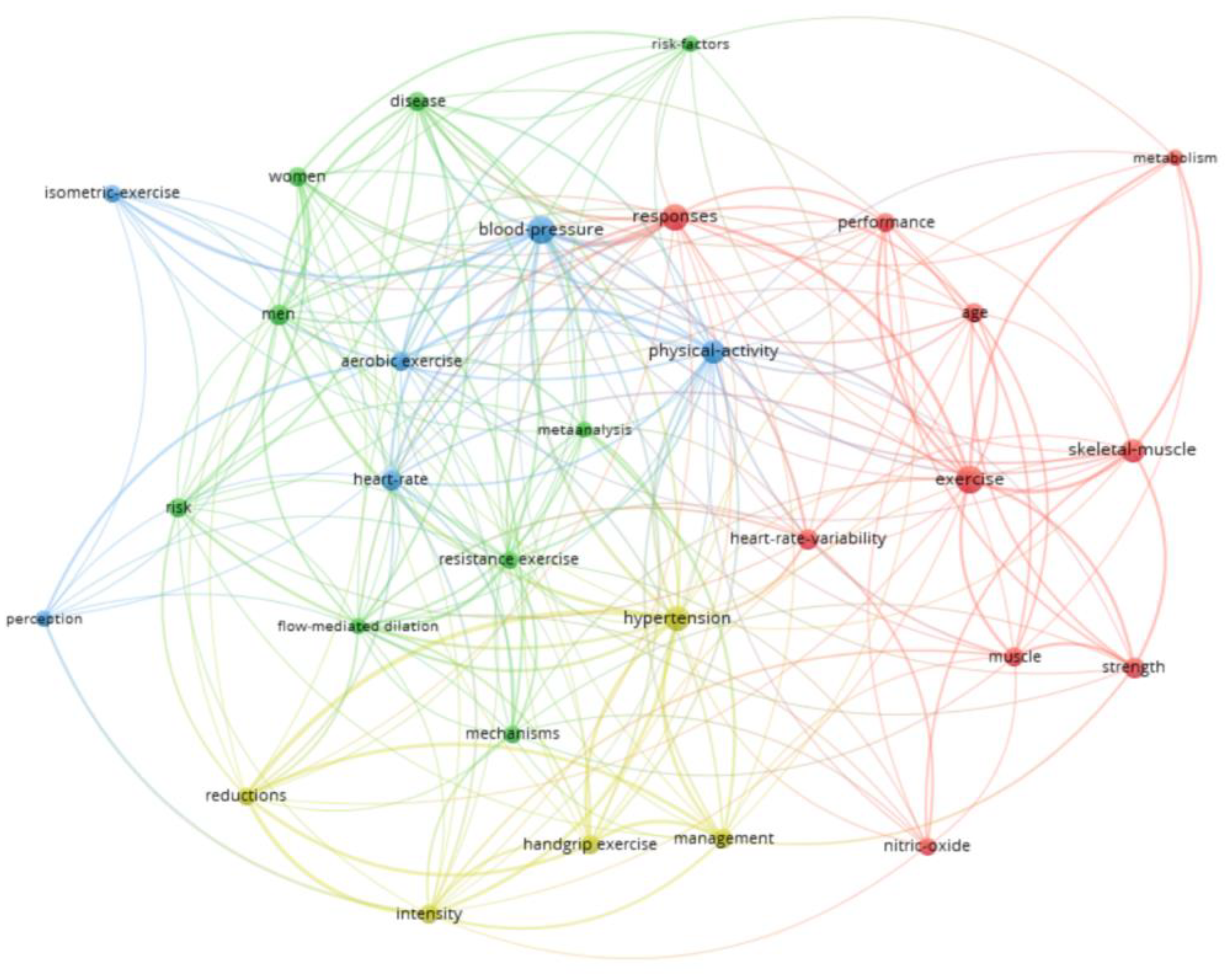
| WoS Categories | Docs. | Journals | Docs. | Publishers | Docs. |
|---|---|---|---|---|---|
| Sport Science | 55 | Journal of applicated Physiology | 8 | Springer Nature | 13 |
| Physiology | 42 | Journal of applicated Physiology | 8 | American Physiological Society | 15 |
| Peripheral Vascular Disease | 32 | American journal of physiology-heart and circulatory physiology | 16 | Lippincott Williams & Wilkins | 10 |
| Cardiac Vascular system | 30 | Journal of the American heart association | 6 | Elsevier | 10 |
| Medicine General Internal | 21 | Pain Medicine | 4 | Oxford University Press | 4 |
| Author’s Name | Country | Cluster | Doc. | Cit. | Most Cited Papers |
|---|---|---|---|---|---|
| Seals, D.R. | USA | n.a. | 5 | 476 | 5 |
| Smart, N.A. | Australia | Yellow | 8 | 1276 | 4 |
| Dieberg, G. | Australia | Yellow | 4 | 391 | 2 |
| Carlson, D.J. | Australia | Yellow | 3 | 384 | 2 |
| Hess, N.C.L. | Australia | Yellow | 3 | 363 | 2 |
| Naugle, K.M. | USA | n.a. | 3 | 469 | 1 |
| Swaine, I.L. | England | Purple | 5 | 155 | 1 |
| Mcgowan, C.L. | Canada | Purple | 3 | 129 | 1 |
| Bek, T. | Denmark | Sky Blue | 8 | 122 | 1 |
| Publication Titles (Publishers) | Doc. | Cit. | JIF | Quartile | % O.A. |
|---|---|---|---|---|---|
| J. of Applied Physiology (American Physiological Soc) | 8 | 468 | 3.3 | Q1 | 8.1% |
| European J. of Applied Physiology (Springer) | 7 | 166 | 2.8 | Q1 | 38.3% |
| American J. of Physiology-Heart and Circulatory Physiology (American Physiological Soc) | 6 | 172 | 4.1 | Q1 | 7.1% |
| J. of Hypertension (Lippincott Williams & Wilkins) | 5 | 167 | 3.3 | Q1 | 22.0% |
| American J. of Cardiology (Elsevier) | 4 | 168 | 2.3 | Q2 | 14.6% |
| European J. of Applied Physiology and Occupational Physiology (Springer) | 4 | 126 | n.a. | n.a. | n.a. |
| Investigative Ophthalmology & Visual Science (Assoc Research Vision Ophthalmology Inc.) | 4 | 113 | 5.0 | Q1 | 99.1% |
| Pain Medicine (Oxford Univ Press) | 4 | 71 | 2.9 | Q1 | 18.5% |
| J. of Pain (Churchill Livingstone) | 3 | 470 | 4.0 | Q1 | 66.4% |
| American J. of Hypertension (Oxford Univ Press) | 3 | 83 | 3.2 | Q2 | 21.2% |
| Hypertension (Lippincott Williams & Wilkins) | 3 | 69 | 6.9 | Q1 | 18.0% |
| Gerontology (Karger) | 3 | 68 | 3.1 | Q3 | 31.2% |
| Clinical Interventions in Aging (Dove Medial Press LTD) | 3 | 63 | 3.5 | Q2 | 98.2% |
| Medicine & Science in Sports & Exercise (Lippincott Williams & Wilkins) | 3 | 43 | 4.1 | Q1 | 15.6% |
| Graefes Archive for Clinical and Experimental Ophthalmology (Springer) | 3 | 31 | 2.4 | Q2 | 29.2% |
| Scandinavian J. of Medicine & Science in Sports (Willey) | 3 | 30 | 3.5 | Q1 | 46.0% |
| J. of Physical Therapy Science (Soc Physical Therapy Science) | 3 | 25 | n.a. | n.a. | n.a. |
| Isokinetics and Exercise Science (IOS Press) | 3 | 14 | 0.6 | Q4 | 5.6% |
| J. of Clinical and Diagnostic Research (Premchand Sha ntidevi Research Foundation) | 3 | 8 | 0.2 | Q4 | 98.5% |
Disclaimer/Publisher’s Note: The statements, opinions and data contained in all publications are solely those of the individual author(s) and contributor(s) and not of MDPI and/or the editor(s). MDPI and/or the editor(s) disclaim responsibility for any injury to people or property resulting from any ideas, methods, instructions or products referred to in the content. |
© 2025 by the authors. Licensee MDPI, Basel, Switzerland. This article is an open access article distributed under the terms and conditions of the Creative Commons Attribution (CC BY) license (https://creativecommons.org/licenses/by/4.0/).
Share and Cite
Ríos Riquelme, M.; Denche-Zamorano, Á.; Salas-Gómez, D.; Castillo-Paredes, A.; Ferrari, G.; Marín-Guajardo, C.; Loro-Ferrer, J.F. Trends and Scientific Production on Isometric Training: A Bibliometric Analysis. Sports 2025, 13, 145. https://doi.org/10.3390/sports13050145
Ríos Riquelme M, Denche-Zamorano Á, Salas-Gómez D, Castillo-Paredes A, Ferrari G, Marín-Guajardo C, Loro-Ferrer JF. Trends and Scientific Production on Isometric Training: A Bibliometric Analysis. Sports. 2025; 13(5):145. https://doi.org/10.3390/sports13050145
Chicago/Turabian StyleRíos Riquelme, Mario, Ángel Denche-Zamorano, Diana Salas-Gómez, Antonio Castillo-Paredes, Gerson Ferrari, Cecilia Marín-Guajardo, and Juan Francisco Loro-Ferrer. 2025. "Trends and Scientific Production on Isometric Training: A Bibliometric Analysis" Sports 13, no. 5: 145. https://doi.org/10.3390/sports13050145
APA StyleRíos Riquelme, M., Denche-Zamorano, Á., Salas-Gómez, D., Castillo-Paredes, A., Ferrari, G., Marín-Guajardo, C., & Loro-Ferrer, J. F. (2025). Trends and Scientific Production on Isometric Training: A Bibliometric Analysis. Sports, 13(5), 145. https://doi.org/10.3390/sports13050145








